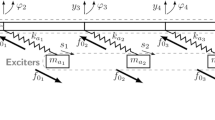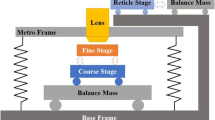Abstract
Structure vibration is known to influence the firing accuracy of a machine gun system. Studying the dynamic characteristics of the machine gun system and reducing its vibration response are crucial. Eigenfrequency optimization based on topology is an emerging vibration suppression technique that reduces structural vibration and stabilizes a machine gun system. This paper presents an effective and efficient method that accomplishes these tasks. The objective function is the frequency of the main vibration mode confirmed by modal and transient dynamic analyses. The frequency is maximized by subjecting topology optimization to mass constraints. Based on topology optimization results, the revised model addresses all structural and manufacturability concerns. Dynamic analysis, exterior ballistics calculation, and experimental test are conducted to verify the effectiveness of the proposed method. Results show that muzzle vibration and structure deformation are reduced and firing accuracy is remarkably improved.
Similar content being viewed by others
References
A. G. Littlefield, E. L. Kathe and R. Durocher, Dynamically tuned shroud for gun barrel vibration attenuation, Smart Structures and Materials 2002: Damping and Isolation, 4697 (2002) 89–97.
H. I. Gimm, K. U. Cha and C. K. Cho, Characterizations of gun barrel vibrations of during firing based on shock response analysis and short-time Fourier transform, Journal of Mechanical Science and Technology, 26 (5) (2012) 1463–1470.
D. Patt, L. Liu and P. P. Friedmann, Simultaneous vibration and noise reduction in rotorcraft using aeroelastic simulation, Journal of the American Helicopter Society, 51 (2) (2006) 127–140.
Y. J. Wu, J. J. Wang and Q. K. Han, Static/dynamic contact FEA and experimental study for tooth profile modification of helical gears, Journal of Mechanical Science and Technology, 26 (5) (2012) 1409–1417.
Y. J. Shin et al., Semi-active control to reduce carbody vibration of railway vehicle by using scaled roller rig, Journal of Mechanical Science and Technology, 26 (11) (2012) 3423–3431.
J. Park, O. Kwon and J. H. Park, Anti-sway trajectory generation of incompletely restrained wire-suspended system, Journal of Mechanical Science and Technology, 27 (10) (2013) 3171–3176.
J. S. Jensen and N. L. Pedersen, On maximal eigenfrequency separation in two-material structures: the 1D and 2D scalar cases, Journal of Sound and Vibration, 289 (4-5) (2006) 967–986.
J. Y. Park and S. Y. Han, Application of artificial bee colony algorithm to topology optimization for dynamic stiffness problems, Computers & Mathematics with Applications, 66 (10) (2013) 1879–1891.
J. Du and N. Olhoff, Topology optimization of continuum structures with respect to simple and multiple eigenfrequencies, Proceedings of 6th world congresses of structural and multidisciplinary optimization (2005).
G. H. Yoon, Structural topology optimization for frequency response problem using model reduction schemes, Computer Methods in Applied Mechanics and Engineering, 199 (25-28) (2010) 1744–1763.
K. Cai, Z. Gao and J. Shi, Compliance optimization of a continuum with bimodulus material under multiple load cases, Computer-Aided Design, 45 (2) (2013) 195–203.
Y. Maeda et al., Structural topology optimization of vibrating structures with specified eigenfrequencies and eigenmode shapes, International Journal for Numerical Methods in Engineering, 67 (5) (2006) 597–628.
P. H. Nakasone and E. C. N. Silva, Dynamic design of piezoelectric laminated sensors and actuators using topology optimization, Journal of Intelligent Material Systems and Structures, 21 (16) (2010) 1627–1652.
A. R. Díaaz and N. Kikuchi, Solutions to shape and topology eigenvalue optimization problems using a homogenization method, International Journal for Numerical Methods in Engineering, 35 (7) (1992) 1487–1502.
N. L. Pedersen, Maximization of eigenvalues using topology optimization, Structural and Multidisciplinary Optimization, 20 (1) (2000) 2–11.
G. Allaire, S. Aubry and F. Jouve, Eigenfrequency optimization in optimal design, Computer Methods in Applied Mechanics and Engineering, 190 (28) (2001) 3565–3579.
B. Xu et al., Topology group concept for truss topology optimization with frequency constraints, Journal of Sound and Vibration, 261 (5) (2003) 911–925.
R. Meske, B. Lauber and E. Schnack, A new optimality criteria method for shape optimization of natural frequency problems, Structural and Multidisciplinary Optimization, 31 (4) (2006) 295–310.
L. Shu et al., Level set based structural topology optimization for minimizing frequency response, Journal of Sound and Vibration, 330 (24) (2011) 5820–5834.
T. D. Tsai and C. C. Cheng, Structural design for desired eigenfrequencies and mode shapes using topology optimization, Structural and Multidisciplinary Optimization, 47 (5) (2013) 673–686.
J. Li et al., Simulation of fire density of gatling gun shooting on light tripod, Journal of Nanjing University of Science and Technology, 37 (2) (2013) 209–214.
S. Jie et al., Dynamics characteristics of automatic mechanism for gas operated and floating barrel operated automatic action, Acta Armamentarii, 35 (6) (2014) 753–761.
Author information
Authors and Affiliations
Corresponding author
Additional information
Recommended by Associate Editor Jun-Sik Kim
Hongliang Hua is a doctoral student at Nanjing University of Science and Technology in China. His current research interests include structural optimization, finite element method, and rigid-flexible coupled dynamics.
Zhenqiang Liao received his Ph.D. degree in Engineering from Nanjing University of Science and Technology in China. He is a Professor at the Department of Mechanical Design, School of Mechanical Engineering, Nanjing University of Science and Technology. His main subjects are multi-body dynamics, vibration reduction for machine gun systems, and weapon structural optimization.
Jie Song is a doctoral student at Nanjing University of Science and Technology in China. His current research interests include impact dynamic analysis of structures, vibration analysis, and nonlinear dynamics.
Rights and permissions
About this article
Cite this article
Hua, H., Liao, Z. & Song, J. Vibration reduction and firing accuracy improvement by natural frequency optimization of a machine gun system. J Mech Sci Technol 29, 3635–3643 (2015). https://doi.org/10.1007/s12206-015-0807-5
Received:
Revised:
Accepted:
Published:
Issue Date:
DOI: https://doi.org/10.1007/s12206-015-0807-5




